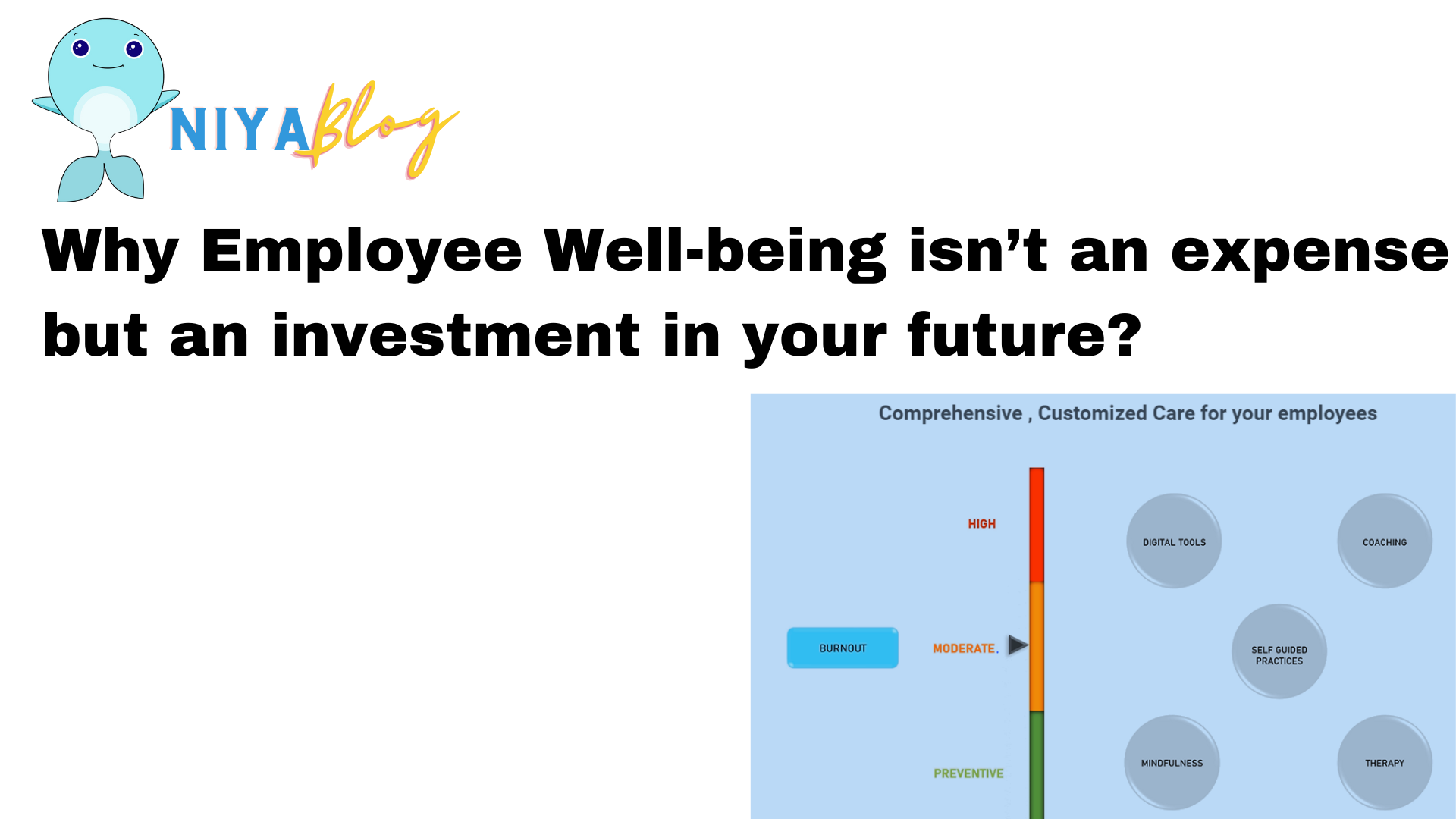The future of work is employee-wellbeing~@Forbes
Employee well-being has become an increasingly important topic in the workplace, and many experts agree that it is indeed the future of work. As organisations recognise the importance of creating a healthy and positive work environment, they are beginning to prioritise employee well-being as a critical factor in their success.
In a recent Future Workplace Virtual Summit, when the senior leaders in HR, Talent, and Corporate Learning were asked about their top priority, more than 68% of HR leaders rated employee well-being and mental health as top priorities. No wonder the corporate well-being market is estimated to grow to $87 billion by 2026.
But, here’s a disconnect. When asked about what they had done to focus on employee well-being, more than 70% of the members talked about flexible work hours, health insurance plans, yoga classes, or gym memberships.
Many felt that employees would feel confident and positive about their jobs like this. But a Gallup report showed that around 75% of employees were experiencing job burnout for a range of reasons:
- Poor work management
- Unmanageable workload
- Unfair treatment at work
Sadly, the gloomy stats aren’t ending here. In India alone, WHO predicted that the economic loss due to mental health conditions between 2012 and 2030 will stand at around US$1.03 trillion. In fact, according to a survey published in Deloitte, more than 46 percent of employees reported that financial stress also emerged as a key contributor to adverse mental health symptoms.
In addition to that, as per a CIPD survey report:
- 37% increase in stress-related absence at work.
- 89% of employees were affected by presenteeism even though they were unwell.
Clearly, the fancy perks and activities that your companies plan aren’t helping employees who still get overly stressed at work. The negative impacts are a barrier to their mental and physical health.
These issues aren’t only affecting individual well-being, and organisations are also impacted because of decreased productivity and performance.
And with psychologists warning about an increase in diseases like depression and even PTSD after the covid, employers need to start carefully planning their employee well-being policies in 2023 and beyond.
But before we dive deep into bridging the gap with Niya, let’s brush up a bit about employee well-being, elements of well-being, and blessings of employee well-being.
What is employee well-being?
Employee well-being is often described as physical well-being, but the right definition captures much more than that. Well-being includes major components that help individuals lead a better life. Wellness is not well-being but a component of employee well-being.
According to experts, there are five core elements of well-being. They include:
- Career
- Social
- Financial
- Physical
- Community
Source: Gallup
Wondering where mental health factors in?
According to a study, it was found that high-engagement cultures had lower occurrences of depression and anxiety. Clearly, employees’ mental health can’t be left out of the conversation. If you want comprehensive and customised care for your employees, in that case, we are all set to partner with organisations to transform employee well-being with our holistic and strategic approach backed by science.
NIYA’s assessment is based on decades of research and provides analysis in 5 well-being dimensions and multiple leading indicators personalised and effective support for improving employee well-being.
Let’s come together to make mental health a shared priority
Schedule a meeting with us
Why should organisations invest in employee well-being?
In organisations, investing in employee well-being can translate to:
- Reduced absenteeism and healthcare costs: If you work proactively for employee well-being, it will tremendously reduce burnout, stress, or sickness. This example will be a great start if you think about how it will impact your ROI. Johnson & Johnson estimated that wellness programs helped save $250 million on healthcare costs, and the ROI was like 2.71$ for every dollar spent on employee well-being.
- Better employee engagement: When you have an employee well-being program or initiatives in place, employees feel connected and consequently happier. A growing body of research suggests a positive correlation between employee well-being and engagement. Here are some statistics that support this idea:
- A survey by the American Psychological Association found that 89% of employees will recommend their company as the best place to work if they support well-being initiatives compared to 67% of employees without such programs.
- A report by Limeade found that when employees feel their employer cares about their well-being, they are 38% more engaged, 18% more likely to go the extra mile, and 14% less likely to leave the company.
- A report by the World Economic Forum found that employees who feel their well-being is a priority are more likely to be engaged, with 88% of engaged employees reporting that their company supports their well-being, compared to just 50% of disengaged employees.
- Improved employee productivity: A significant body of research suggests a strong correlation between employee well-being and productivity. Here are a few statistics that support this idea:
- According to a study by the World Economic Forum, happy employees are 12% more productive than their unhappy counterparts.
- Research conducted by the University of Warwick found that happy employees are 20% more productive than unhappy colleagues.
- The American Psychological Association reports that employees who feel valued are more likely to be engaged and productive at work.
- The Health and Safety Executive (HSE) found that companies with good health and well-being policies have a 31% higher productivity rate than those that don’t.
- According to the Centers for Disease Control and Prevention, companies that implement wellness programs experience a median of 28% reduction in sick days and a 26% reduction in healthcare costs.
- Higher employee morale: There is a strong link between well-being and morale. When employees feel supported and valued, they are more likely to have higher morale, leading to increased motivation, job satisfaction, and productivity. Here are a few examples of how employee well-being can positively impact morale:
- When employers prioritise employee well-being, it sends a message that the organisation cares about its employees’ overall health and happiness. This can lead to a stronger sense of loyalty and commitment among employees, which can boost morale.
- Investing in employee well-being can help reduce stress, anxiety, and burnout, which can negatively impact morale. When employees feel supported in managing their stress levels and maintaining a healthy work-life balance, they are more likely to have a positive outlook and feel more engaged at work.
- When employees have access to resources to help them manage their mental health, such as counselling services or mental health days, it can help improve morale. This shows that the employer recognises the importance of mental health and is committed to supporting employees in this area.
Overall, by investing in employee well-being, employers can help improve morale, which can positively impact the overall health and success of the organisation.
The Challenges
While well-being initiatives can have many benefits for employees and organisations, several challenges can make it difficult to implement them effectively. One of the biggest challenges is that we still use traditional methods to woo tech-savvy employees. Besides that, here are some of the most common challenges of wellness initiatives in the workplace:
- Limited access: Wellness initiatives may not be accessible to all employees, particularly those who work remotely or have limited access to resources.
- One-size-fits-all approach: Wellness programs that are not tailored to employees’ specific needs and preferences may not be effective or sustainable.
- Lack of follow-up: Some programs may have a short-term focus or lack follow-up, making it challenging to achieve long-term results.
- The stigma around mental health: In some workplaces, there may still be a stigma attached to mental health issues, making it challenging to implement wellness initiatives focusing on mental health support.
- Continuity issues: Organisations often share a helpline number to navigate the times of distress. However, the lack of connectivity because of sharing your concerns with a new person every time makes it hard for employees to keep up with their well-being.
Bridging the gap with Niya: Comprehensive and Customised Care for your Employees
The first step is understanding your existing culture and how it might impact your employees on any given day. But you can’t discuss that with every executive and manager. This is where NIYA comes to your rescue.
Since we believe no two individuals are the same, we first assess the level of emotional and mental stress of your employees and the reasons behind that stress which enables us to give hyper-personalised support through clinically validated digital tools and specialised coaching and counselling sessions.
Our chat and video call support within the app will help your employees get the required support at any given time of day. In short, we provide holistic, hyper-personalised, end-to-end customised employee well-being support to your employees in a completely confidential manner.
In addition, you will get aggregated anonymised data to help you draft targeted interventions that will increase employee productivity, performance, and engagement and positively influence your business’s bottom line.
Our world needs caring workplaces for Happier, Healthier and more productive people.
Let Niya support you in building mental health, resilience, and well-being at work.
Connect with us


